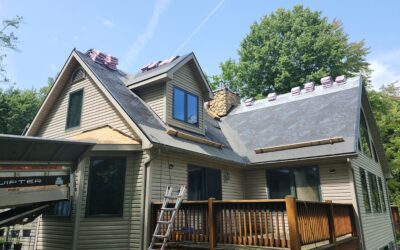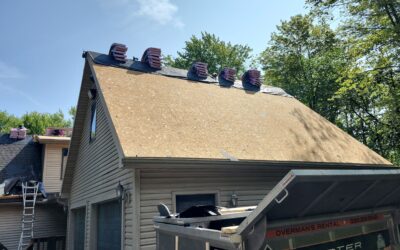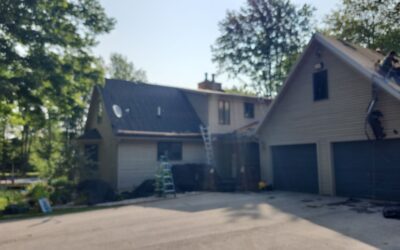Why Does My Roof Only Leak Sometimes? Intermittent Roof Leaks Explained
Roof leaks can be one of the most frustrating and elusive problems a homeowner can face. Often, they don’t appear consistently, and it may feel like the roof only leaks during certain conditions—such as during heavy rain or when there are strong winds. Understanding why your roof leaks intermittently is key to both preventing further damage and knowing how to handle repairs efficiently.
This blog will explore the reasons why roof leaks may not happen every time it rains, how weather conditions contribute to this behavior, and how roof components such as ridge vents, skylights, chimneys, and pipe vents may all play a role. Additionally, we’ll discuss the importance of maintenance in detecting and preventing leaks before they become significant issues.
Understanding Intermittent Roof Leaks
Roof leaks that happen sporadically can be difficult to diagnose because they may not appear during every rainstorm or adverse weather event. However, when they do occur, the damage can still be significant, leading to water stains, ceiling damage, and even mold growth in some cases. So, what makes some roof leaks only occur occasionally?
Why Do Roof Leaks Happen Intermittently?
There are several reasons a roof may leak intermittently. Some of the most common causes include:
- Weather Variability: Roof leaks often occur only under certain weather conditions. For example, a roof may only leak during heavy rain or when the wind is blowing at a specific angle. This happens because of the increased water pressure or the way the wind directs water toward particular areas of your roof.
- Shifting Roof Materials: Roofing materials, such as shingles or tiles, can shift over time due to weather, aging, or improper installation. These shifts can create small gaps or misalignments that only allow water to penetrate during specific conditions, such as when the rain is heavy or the wind is blowing in a certain direction.
- Flashing Issues: Flashing is the material used to seal joints and intersections on the roof, such as around chimneys, vents, or skylights. If the flashing becomes damaged or improperly installed, it can allow water to seep in only under certain conditions, like when rain is heavy or wind is at a specific angle.
- Clogged or Damaged Gutters: If your gutters are clogged or damaged, water may pool on the roof and seep under the roofing materials during heavy rain. However, during lighter rainfall, the water may be able to flow off the roof without issue, causing the leak to only appear intermittently.
- Hidden Roof Damage: Sometimes, the cause of the intermittent leak can be difficult to pinpoint because it may be hidden from view. A crack or gap in the roofing materials may only let in water during a heavy downpour or when specific weather conditions occur.
The Impact of Horizontal Rain on Your Roof
One significant factor that can cause an intermittent roof leak is horizontal rain. Horizontal rain is rain driven by strong winds, which causes the rain to hit your roof from a side angle instead of falling straight down. This can push water underneath shingles, tiles, or other roofing materials in areas that may not usually be vulnerable to leaks.
How Horizontal Rain Affects Roof Leaks:
- Exposed Edges: Roofs that are not well-maintained or have damaged flashing around the edges are particularly susceptible to horizontal rain. The wind can force rain under the roofing material where it would normally be protected.
- Wind Direction: The direction of the wind is crucial in determining how much of the roof will be affected. If the wind is blowing from a direction that directs rain toward a specific part of your roof, such as the ridge, valley, or a poorly sealed joint, it can create an intermittent leak.
- Leaks in Hard-to-Reach Areas: Sometimes, horizontal rain can expose problems in hard-to-reach places that are otherwise difficult to inspect. If the roof has areas where water tends to collect or infiltrate, it may not be immediately visible unless the rain is coming in from the side.
Horizontal rain can often mimic the same issues that might occur during a heavy downpour or storm, making it difficult for homeowners to know exactly what caused the leak. It’s important to consider both wind and rain direction when inspecting your roof for damage.
The Importance of Regular Roof Maintenance
Routine roof maintenance is essential for identifying and resolving potential issues before they cause intermittent or full-blown leaks. Regular inspections help detect areas that may be at risk for leaks, such as cracked shingles, damaged flashing, or clogged gutters.
Why Regular Maintenance Matters:
- Early Detection of Roof Damage: Regular roof inspections by a professional can uncover damage that may be causing intermittent leaks. Even minor issues can be addressed before they lead to more significant leaks.
- Improved Longevity of Roofing Materials: Keeping your roof in good condition can extend its lifespan and reduce the risk of leaks. By cleaning gutters, checking for loose shingles, and ensuring the roof is properly sealed, you can prevent water infiltration before it becomes a bigger problem.
- Preserving Your Home’s Interior: Roof leaks, even if they only happen intermittently, can still cause significant damage to your home’s interior. Water stains, mold, and mildew growth are just a few of the issues that can arise from a leaking roof. Regular maintenance can help prevent these problems.
- Cost-Effective Repairs: Catching roof issues early can save you money in the long run. Minor repairs are much more affordable than major roof replacements, which may be necessary if a small leak is left untreated for too long.
- Keeping the Roof Warranty Intact: Some roofing materials come with warranties that require proof of regular maintenance. By scheduling annual inspections and addressing any issues early, you can ensure your warranty remains valid.
Ridge Vents and Leaks: What You Need to Know
Ridge vents are a common feature of many modern roofs, helping to improve ventilation by allowing hot air and moisture to escape from the attic. While ridge vents are effective at keeping your attic dry and properly ventilated, they can also be a potential source of leaks if not properly maintained or installed.
How Ridge Vents Can Contribute to Intermittent Leaks:
- Improper Installation: If a ridge vent is not correctly installed, it can leave gaps or cracks that allow water to seep into the attic, particularly during heavy rain or high winds. Over time, the sealant around the vent can degrade, leading to leaks.
- Clogged or Blocked Vents: If debris such as leaves or twigs clog the ridge vent, it can prevent moisture from escaping the attic. This can create condensation issues, which may eventually lead to leaks or water damage.
- Damaged Vent Caps: Ridge vent caps are designed to keep water out while still allowing airflow. If the cap becomes damaged or deteriorates, it can lead to water infiltration that may not be noticeable until the conditions are right (heavy rain or strong winds).
- Ice Dams: In colder climates, ridge vents can be a contributing factor to ice dam formation if they are not properly sealed. When warm air escapes from the attic, it can melt the snow on the roof, causing water to flow down to the eaves, where it can freeze. This frozen water can eventually seep into the house, causing leaks.
Uncovering Common Leak Sources
In addition to ridge vents, there are several other components of your roof that can contribute to intermittent leaks. Let’s take a closer look at some common sources of roof leaks:
1. Pipe Vents
Pipe vents, also known as plumbing vents, are crucial for allowing air to enter the plumbing system and enabling wastewater to flow freely. However, over time, the seals around these vents can crack or deteriorate, leading to leaks around the base of the vent. Pipe vent leaks are particularly common after severe weather or temperature fluctuations.
- Causes: Cracked or worn-out seals around the pipe vent, improper installation, and general wear over time.
- Intermittent Leaks: The leaks may only occur when rainwater or melting snow accumulates around the base of the vent, or during heavy rain when the water flows in a certain direction.
2. Skylights
Skylights add natural light to your home, but they can also be a source of roof leaks if not properly installed or maintained. Skylights are vulnerable around their edges and flashing, where gaps or cracks can allow water to seep in. Leaks around skylights can also occur intermittently when certain weather conditions (like strong winds or horizontal rain) direct water toward the skylight.
- Causes: Improper installation, degraded flashing, or cracked seals around the skylight.
- Intermittent Leaks: Skylight leaks tend to occur during heavy rainfall or when the wind blows water directly toward the skylight.
3. Chimneys and Chimney Caps
Chimneys are another common source of roof leaks. Water can infiltrate around the chimney’s flashing, particularly at the base where the chimney meets the roof. Additionally, chimney caps, which are designed to keep rain out of the chimney, can become damaged or clogged, allowing water to enter the chimney and the surrounding roof area.
- Causes: Damaged flashing, clogged chimney caps, or improperly sealed areas around the chimney.
- Intermittent Leaks: Leaks around chimneys often occur during heavy rain or when strong winds drive rain toward the chimney.
Conclusion
Intermittent roof leaks can be caused by a variety of factors, ranging from shifting roofing materials to weather-related issues like horizontal rain. Regular maintenance and inspections are key to identifying and preventing roof leaks before they cause significant damage to your home. Ridge vents, skylights, pipe vents, and chimneys are common areas where leaks can develop, so it’s important to keep these components in good condition.
By addressing potential issues early and investing in professional roof inspections, you can prolong the lifespan of your roof and avoid the headaches that come with sporadic leaks. Whether your roof is old or new, staying on top of regular maintenance will help keep your home dry and safe for years to come.
 (440) 307-2060
(440) 307-2060


